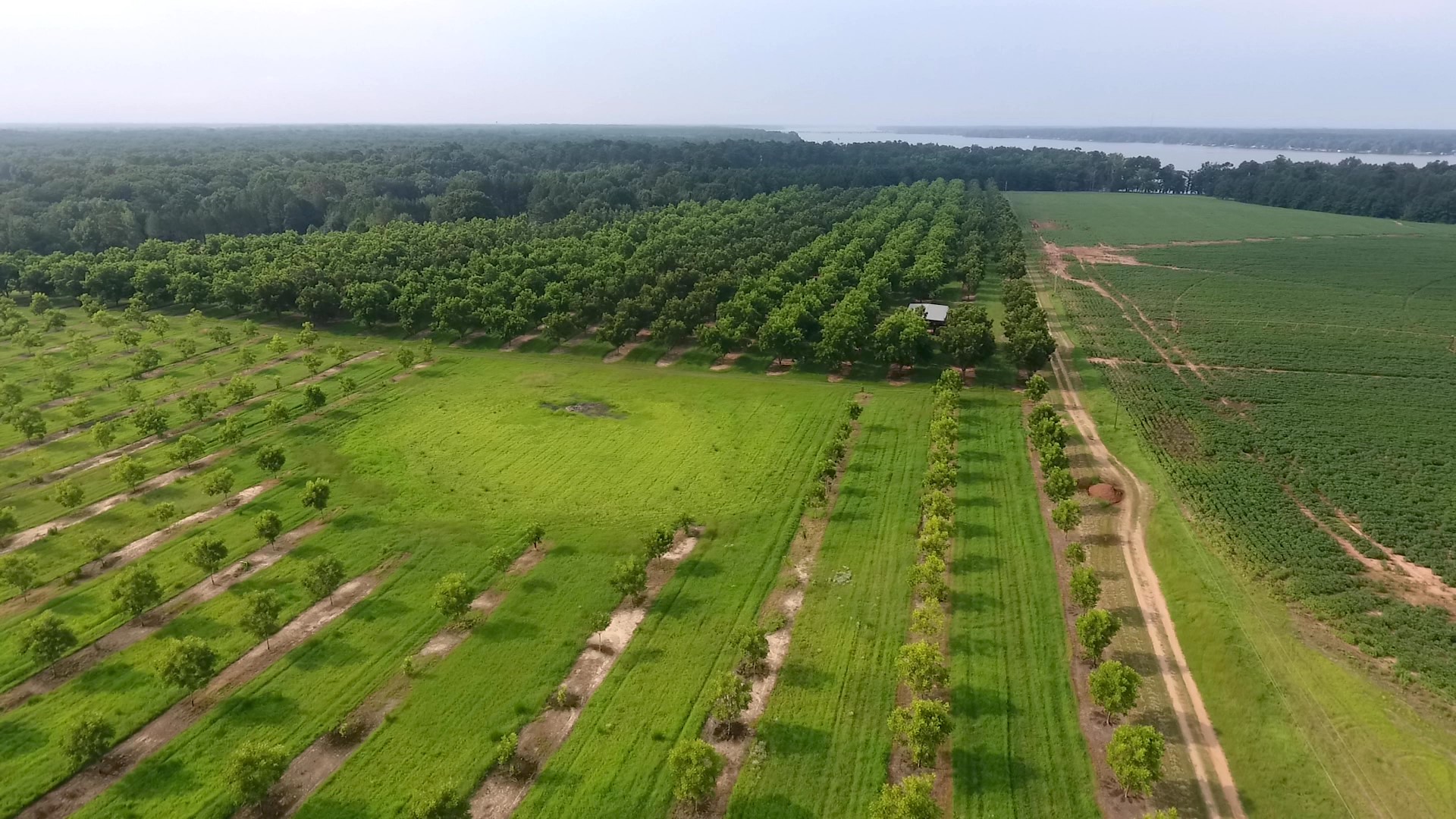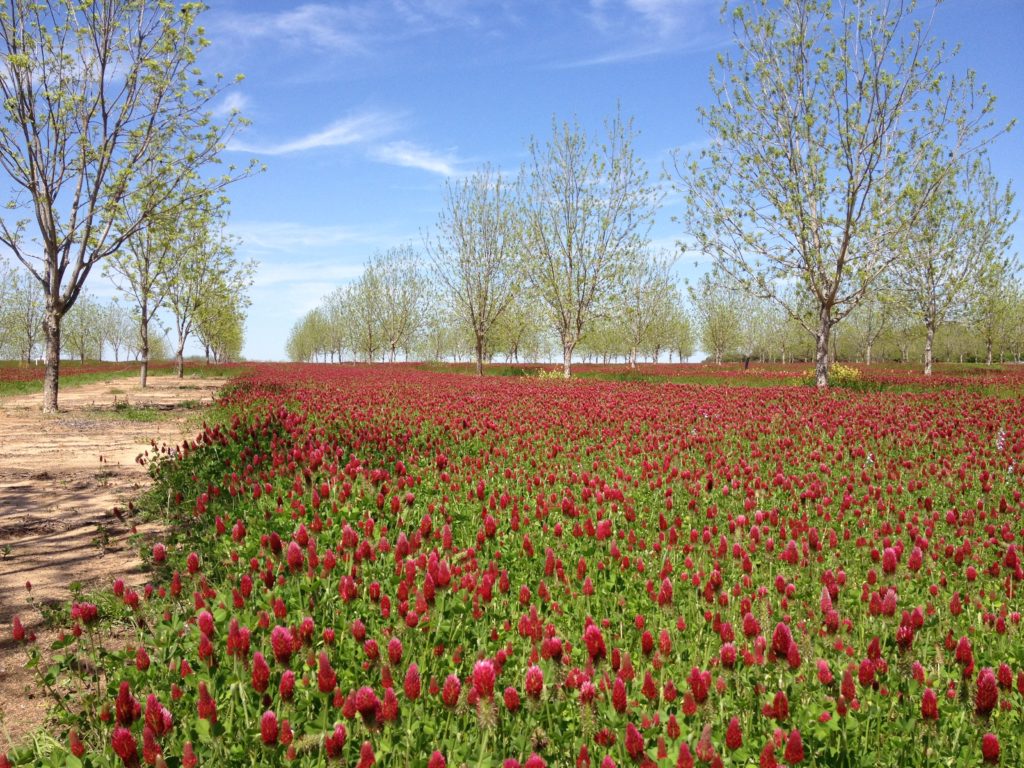What Are a Pecan Orchard’s Ecosystem Services?

Photo by Russell Chapman
Bear with me here. I promise I’ll get to pecans in a minute. Just for the sake of clarity, this is how climate change works in a nutshell. It follows a simple set of chemical and physical facts involving water vapor and infrared light that rests on the physical and chemical laws of the universe.
Each day our sun bathes the earth with nearly every form of light known—X-rays, gamma rays, visible light, ultraviolet light, radio waves, microwaves, and infrared radiation—but not all of this light reaches the earth’s surface. Clouds reflect about 30 percent of this light; airborne water vapor absorbs some more, leaving about half of the sun’s light that reaches the earth’s surface to be absorbed by plants, land, and sea. Therefore, the earth naturally warms. These surfaces radiate infrared light back into the atmosphere. That infrared light is absorbed by water vapor and transferred to varying extents to nitrogen and oxygen molecules in the atmosphere that can’t absorb it otherwise, warming the earth. Without this, our planet would be an ice ball.
This process stores just enough solar energy to make the planet hospitable to life as we know it and lets just enough leak out to keep the planet from getting too hot, sort of like the earth’s thermostat. So, how does carbon dioxide fit into this scenario?
Carbon dioxide, or CO2, happens to absorb those frequencies of infrared light that water vapor lets pass back into space. In essence, CO2 plugs up the holes through which some of the infrared light escapes. As more CO2 is released into the atmosphere to plug up the holes, the earth continues to warm.
Pop culture solutions to this problem focus on decreasing fossil fuel use, investing in alternative energy, planting forests, and relying on a host of geoengineering schemes, all of which have merit, but these solutions become politicized so much that many of us roll our eyes at the latest talking head. But the IPCC’s recent report suggests that agricultural land can play a major role in mitigating the effects of climate change as crops and plants absorb carbon, interact with microbes in the soil to produce organic matter, and store carbon underground in a way that outlasts the growth and decay of aboveground vegetation.
So, just how good are pecan orchards when it comes to storing carbon and providing other environmental benefits—often called “ecosystem services”? It depends on how they are grown, but potentially, pecan orchards are among the best.

At the UGA Tifton Campus Ponder Research Farm in Ty Ty, Georgia, researchers discovered that inter-planting clover in the pecan orchard added 3,500 to 5,500 pounds of dry matter per acre and raised the soil’s organic matter level. (Photo by Lenny Wells)
Pecan orchard systems have several things going for them. For one, pecans are large, long-lived trees and can thus store significant amounts of carbon for a long time. Like all plants, as pecan trees “breathe in” carbon dioxide, it combines with water in the presence of sunlight to make sugar (carbohydrates) and the oxygen we breathe. This process is called photosynthesis. Based on calculations by Kraimer et al. (2001), a mature (approximately 15-year-old) pecan tree has a biomass of 2,795 pounds per tree and accumulates approximately 394 pounds of biomass per year. Roughly half of this biomass is carbon collected via photosynthesis.
Based on these calculations, Mexal et al. (2003) suggested that a model mature pecan orchard in New Mexico would produce 20,000 pounds of biomass per acre per year with annual nut production of 3,100 pounds per acre. Their calculations show that for every unit of carbohydrate created by a pecan tree, nearly 1.5 units of CO2 are removed from the atmosphere. About half of the fixed CO2 remains in the tree after harvest. A very small portion (less than 10 percent) is removed with the crop, about 16 percent is burned in the form of limbs/debris removed during harvest, and nearly 30 percent goes back into the soil as organic matter. All told, when the New Mexico-West Texas region had only about 2 million pecan trees, these trees would remove about 560 million pounds of carbon dioxide from the region, roughly equivalent to 41,500 vehicles driving 15,000 miles per year.
However, as you know, pecans are grown in many climates under a host of environmental conditions across the Pecan Belt, and this diversity can generate variation from the above example from one region to the next. In more humid areas of our country, pecan trees may grow much larger and at different rates than they do in the arid Southwest simply as a result of soil moisture. Generally, the pecan tree population’s age structure in humid regions (stretching from East Texas and Oklahoma across to Georgia and North Carolina) is older than that of the West. While this may not be good for consistent pecan production, the longer a tree lives, the more carbon it stores. A large percentage of our acreage in the southeastern United States was planted before 1984. By comparison, almond orchards are generally removed after about 25 years. Thus, theoretically, pecan orchard systems could be better at carbon storage than almonds.
Additionally, orchard soils tend to be vast reservoirs of carbon. This storage occurs by happenstance in non-tilled systems like pecan orchards. Brian Barth with Modern Farmer put it best: “Just like the trees in a forest, crops interact with microbes in the soil to produce organic matter, a stable form of underground carbon storage that outlasts the growth and decay of aboveground vegetation.” This carbon storage in the soil then directly impacts the crops grown there. According to a 2008 paper published by the U.N. Food and Agriculture Organization, “[increased levels of soil carbon] translate into better plant nutrient content, increased water retention capacity and better structure, eventually leading to higher yields and greater resilience.”
Pecan orchards in humid regions are essentially meadows with trees inter-planted. Most are composed primarily of grasses. Many orchards are also inter-planted with legumes like clover to serve as sources of supplemental nitrogen, harbors for beneficial insects, and organic matter. Some of the better agricultural soils in the country—like those of the Great Plains—have excellent organic matter levels of 4 to 7 percent. Because of the warm, humid climate’s effect on microbial activity in the soil, organic matter is broken down rapidly in the Southeast. As a result, agricultural soils on the sandy land of the southeastern Coastal Plain have low organic matter levels ranging from 0.5 to 2 percent. However, pecan orchard soils in the region average 3.6 percent, a level approaching that of the Great Plains and consistent with natural hardwood forests of the Southeast (Wells, 2009). The addition of clover to an orchard soil raises the organic matter level further and provides an additional 3,500 to 5,500 pounds of dry matter per acre. The increase in dry matter all adds up to more carbon stored in the soil.
The almond industry has quantified its carbon footprint through a process called “life-cycle analysis,” which also considers the carbon used to produce the crop. The team of researchers from the University of California, Davis, and UC Agriculture and Natural Resources demonstrated that the production of 1 kilogram of almonds produces less than 1 kilogram of carbon emissions. By comparison, beef has been shown to produce 20 kilograms and vegetables about 2 kilograms of carbon emissions. Much of the offset within almond production comes from the use of almond by-products (hulls, shells, tree prunings) for renewable energy and the large amounts of carbon stored in the trees and soil over the 25-year life span of the orchard (Marvinney et al., 2015).
While we don’t use many of our by-products for renewable energy at this point (we could), our trees are longer-lived than almond trees and can store a significant amount of carbon. It would be in the industry’s best interest to conduct a life-cycle analysis of pecan production in the three growing regions to determine pecan production’s exact carbon footprint so that we can then utilize this information in the future. The industry could use this knowledge as a defense against attacks regarding our carbon emissions, a marketing tool, and a data source for a future that will likely involve some form of payment to growers for their orchard acreage’s ecosystem services.
In addition to carbon storage, pecan orchards provide other ecosystem services like biodiversity. Most modern agricultural systems are considered biological deserts because of the intensive human selection for a single species, which naturally comes with agricultural production. Pecan orchards, on the other hand, especially in the humid and semi-humid regions, are often not typical monocultures. Many orchards are diverse by nature and comprise multiple varieties of pecan trees of different ages and sizes. Native pecan groves are even more diverse. This diverse architecture is attractive to a host of other species. Diversity is also good for growing pecans because it keeps pest pressure down. The combination of grasses, legumes, and weeds that make up the trees’ understory serves various functions, from nesting habitats for birds to sources of nectar for pollinators.
As a point of interest in this regard, in 2012, I cataloged 202 species (plants, fungi, birds, insects, reptiles, mammals, mollusks, and amphibians) throughout the year in my travels through southeastern pecan orchards. These are just the species I could identify. There are many more out there. Only 40 percent of the species I identified were considered pests. A 2013 Texas pecan orchard survey, titled “Spiders in Pecans in Central Texas,” documented 162 species of spiders from 26 families, which serve as important natural enemies.
Pecan orchards also provide the oxygen we breathe, serve as screens to trap dust and other pollutants in the air, reduce noise from highways, act as windbreaks, provide shade for a cooler microclimate, and enhance the beauty of the landscape.
We, within the industry, need to begin viewing all of a pecan orchard’s “ecosystem services” as benefits that will provide us an opportunity to promote the healthy production of our pecans. In many recent articles and reports I have read, it seems that the potential environmental benefits of agriculture are gaining increased media attention. This interest will likely only increase with future generations. Many farmers are also calling for parity pricing within agriculture to pay farmers more realistically for the cost of what they produce. We will likely see programs one day which will pay farmers for the benefits their land provides as a way of helping to enhance farm income without causing the world’s food supply to grow too expensive. We want pecans to have a seat at the table when that time comes, and one way to ensure we have that seat is to understand just what we have to offer.

